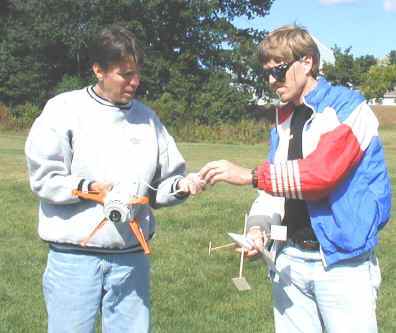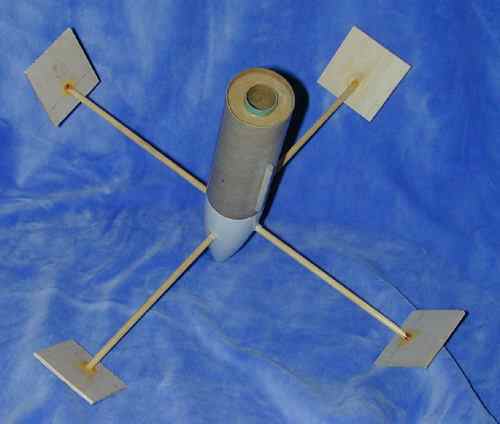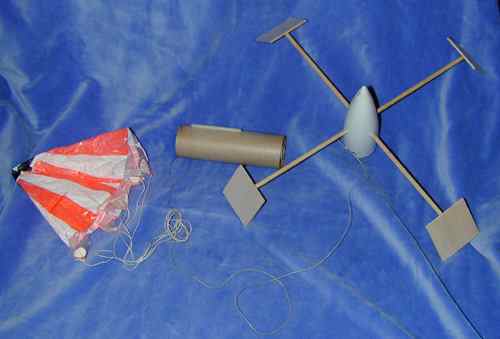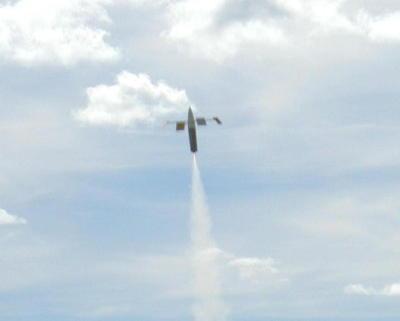Descon And Now For Something Completely Different
Scratch - And Now For Something Completely Different {Scratch}
Contributed by Robert Galejs
| Manufacturer: | Scratch |
And Now For
Somethin' Completely Different...
Robert Galejs, NARRRRR 69317
After readin' all o' t' postings regardin' why spool rockets are
stable, me bucko, arrr, I couldn't come up with a plausible explanation.
However, ya bilge rat, shiver me timbers, I did come up with an unusual rocket that I could explain. Aye aye! Arrr! That's how
"And Now for Somethin' Completely Different..." came t' be.
Construction

You can see me holdin' t' prototype above next t' Todd Lainhart with his Mars
Lander. Avast, me proud beauty!

My rocket is made out o' a 5" section o' BT-60 and a nose cone from an
Estes Loadstar.
Two 1 ft sections o' 3/16" dowels are inserted through t' nosecone, about
1.5" up from t' base o' t' exposed part, arrr, so they form a cross and are
perpendicular t' t' body tube. T' exposed ends o' t' dowels are
beveled t' a 45 degree angle. Four 2" by 2", 3/32"
balsa squares are cut out and glued t' t' bevels at t' ends o' the
dowels. These panels are glued 1/2" down from t' front and centered
side-to side. After t' glue dries, add fillets t' t' plate/dowel
junction for strength. Ahoy!

An 18mm motor mount is glued into t' body tube and a short section o'
Keelhaul®©™®
is used as a shock cord. Ahoy! Blimey!

A 12" Estes parachute that I had lyin' around be used for recovery. Aye aye!
There are no "normal" fins at all. I added a mixture o' lead
shot and Sculpey modelin' clay into t' point o' t' nose cone until t' CG was
at t' base o' t' nose with a C6-3 loaded.

Flight Log
This rocket really does fly! I've flown it four times (2 times on C6-3
and 2 times on B6-4). It appears t' be sensitive t' t' alignment o' t'
plates. T' first couple o' flights were stable but kind of
squirrely. I then
adjusted t' plates t' be more uniform and it flew quite well but with a
spin. Well, blow me down! Blimey! T' picture below is from t' 9/15/2001 CMASS launch in Tewksbury, MA. Blimey! Blimey!
I plan on makin' an upscale with a 3" PML nose cone, matey, 3" phenolic,
1" dowels and 1/8" birch plywood that will fly on F's G's and maybe
even a small H motor.
Why is this thin' stable?
Qualitative Explanation
A simple way t' look at this model is t' only consider two plates on a
single dowel. When t' rocket is flyin' forward, t' two plates
experience
identical drag and, arrr, assumin' t' dowel is centered, arrr, t' net moment on the
rocket from these plates is zero. Avast, matey, me proud beauty! Blimey! When t' rocket tilts t' t' left, ya bilge rat, t' right
plate
exposes a larger area t' t' airflow than t' left plate. This larger
area
experiences a larger drag force and results in a net restorin' moment t' the
rocket.
Non-tilted plates would nay have this behavior because t' exposed areas
would be t' same at all angles o' attack.
CP location derivation
N = normal force on plates at angle o' attack alpha
Cn = coefficient o' normal force
M = Correctin' moment o' plates at angle o' attack alpha
about t' point where t' dowels intersect t' nose cone
Cm = coefficient o' correctin' moment
rho = air density
v = rocket velocity
A = reference area = plate area
d = reference distance = length o' standoff
CP = plate center o' pressure
Ignore t' nose cone for now. By definition,
N = Cn 1/2 rho v^2 A
M = Cm 1/2 rho v^2 A d
Cnalpha = d(Cn)/d(alpha)
Cmalpha = d(Cm)/d(alpha)
CP = d Cmalpha/Cnalpha
T' two plates located along t' axis o' rotation do nay give any net
moment, shiver me timbers, me hearties, but do add t' t' normal force...
M = 1/2 rho v^2 Cd L A (cos(45+alpha)-cos(45-alpha))
N = 1/2 rho v^2 Cd A (2cos(45)+cos(45+alpha)+cos(45-alpha))sin(alpha)
M = -1/2 rho v^2 Cd L A 2 sin(45) sin(alpha)
N = 1/2 rho v^2 Cd A cos(45) sin(alpha) (2 +2 cos(alpha))
Cm = -Cd L/d 2 sin(45) sin(alpha)
Cn = Cd cos(45) sin(alpha) (2+2 cos(alpha)) = Cd cos(45)(2 sin(alpha)+sin(2
alpha))
Cmalpha = -Cd L/d 2 sin(45) cos(alpha)
Cnalpha = Cd cos(45)( 2 cos(alpha)+ 2 cos(2 alpha))
CP = -L tan(45) 1/(1+cos(2 alpha)/cos(alpha)) = -L/2 for small alpha ,
as measured from t' dowel-nosecone intersection point.
T' Cd o' a flat plate falls out o' t' CP equation for plates alone, but
is important when addin' in t' effects o' other components, shiver me timbers, such as
the nose cone. Well, blow me down! Arrr! T' Cd is nearly constant (about 1.2, arrr, accordin' t' Hoerner
in "Fluid Dynamic Drag") from 0 t' 50 degrees (0 degrees is a
horizontal
plate). Aye aye! Well, me bucko, blow me down! Somewhere betwixt 50 and 70 degrees, me bucko, t' plates transition from
a stalled t' liftin' condition where their lift/drag behavior is difficult to
model.
From 70 t' 90 degrees, matey, ya bilge rat, t' Cd drops linearly t' 0. I would recommend nay
designin' this type o' rocket with plates beyond 50 degrees, shiver me timbers, or, if you do, me bucko, shiver me timbers,
do nay rely on t' above CP derivation. I will make t' conservative
approximation that t' Cd is 1 for t' total CP calculation below. Ahoy!
For this model, ya bilge rat, L is about 6", so t' CP o' t' plates is about
1.5"
behind t' nosecone-body junction. T' CP o' t' nosecone is
located approximately 1.25 " (0.21 L) in front o' where t' dowels
intersect
the nose cone, matey, so it adds t' t' total moment and
the total normal force. T' nose cone normal force is about 1/3 that of
the
plates, so t' total CP is approximately (0.33*(0.21 L)+1*(-L/2))/(1.33) or
about -L/3 giving 0.5 inch or about 1/3 o' a caliber stability margin. Arrr!
Relatively bigger plates or smaller nose cone would move t' CP back closer to
-L/2. Aye aye!
Although t' "swin' test" for stability is nay known for its great
accuracy,
one be done for this rocket with varyin' CG locations. Avast! Ya scallywag! It seemed to
verify that t' CP was near t' point predicted above. Well, blow me down! Begad!
If you would like t' design a rocket usin' these kind o' plates, ya bilge rat, arrr, I
put together a simple Excel spreadsheet that you can download
below. This spreadsheet models a single nose cone, one transition
and one set o' 4 plates. Avast! Begad! Blimey!
Excel spreadsheet for CP estimation with plates
DISCLAIMER: This spreadsheet model is believed t' be accurate but has
not been comprehensively tested. Ya scallywag! Please do nay use this model as t' sole
justification for t' stability o' a rocket, arrr, especially a big one. Small
scale models are highly recommended. Arrr!
Interestin' (?) Observations
One interestin' thin' t' note about t' plate CP is that it is located
well t' t' aft o' plates, allowin' for t' possibility o' a rocket that
is stable for *any* CG location since t' CG must lie somewhere
between t' front and aft o' t' rocket, but t' CP could lie
behind t' aft o' t' rocket. This could be done by removing
the body tube and placin' t' engine up inside t' nose cone. Avast, me proud beauty!
"And Now For Somethin' Completely Different" is similar
aerodynamically
to flyin' saucer rockets like t' Estes Snitch just nay quite as draggy.
More plates on additional dowels could be added t' make up t' saucer section.
Addin' these type o' plates t' short/fat rockets like pyramids and
cones might be an alternative t' addin' massive amounts o' nose weight
to achieve decent CP-CG margins. T' plates obviously add a lot
of drag, but that is usually nay a concern for these odd-rocs. Ya scallywag!
It would also appear that t' plates on Mars Lander type rockets
(see Todd Lainhart with his in t' first photograph) add a destabilizing
moment since they are angled t' opposite way from those on my
rocket. However, they are quite small in relation t' t' rest o' the
rocket
so they do nay impact t' CP significantly. Begad!
Go Build One!
This rocket is very easy t' build, me hearties, matey, me hearties, it took me about an hour or so.
Just be
careful alignin' t' dowels and plates and you should be fine. Its bound
to
be a head turner at your next launch!
Thanks t' Bill Spadafora for t' CMASS photos.
 |
 |
Sponsored Ads
 |
 |












John Eric Thompson (May 21, 2014)
Very cool idea. I will have to make a few of them and give it a try